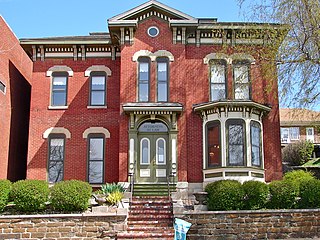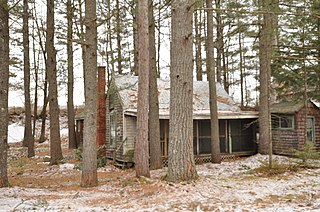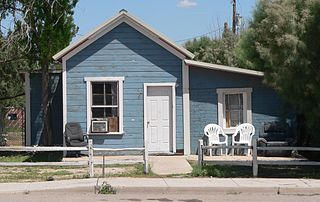
San Felipe de Neri Church is a historic Catholic church located on the north side of Old Town Plaza in Albuquerque, New Mexico. Built in 1793, it is one of the oldest surviving buildings in the city and the only building in Old Town proven to date to the Spanish colonial period. The church is listed on the New Mexico State Register of Cultural Properties and the National Register of Historic Places and has remained in continuous use for over 200 years.

The Walter Field House is a historic residence located along Reading Road in northern Cincinnati, Ohio, United States. Built in the 1880s to be the home of a prosperous local businessman, it features elements of popular late-nineteenth-century architectural styles, and it was produced by one of the city's leading architects. It has been named a historic site.

The Great Atlantic and Pacific Tea Company Warehouse is a historic formerly commercial building at 150 Bay Street in Jersey City, Hudson County, New Jersey, United States. Built as a warehouse for The Great Atlantic & Pacific Tea Company (A&P) in 1900, it is the major surviving remnant of a five-building complex of the nation's first major grocery store chain. It was designated a National Historic Landmark in 1978, and now houses a mix of residences and storage facilities.

The Park United Presbyterian Church is located at 14 Cortland Street in Highland Park, Michigan. It was built in 1910 as the Highland Park Presbyterian Church, listed on the National Register of Historic Places in 1982, and designated a Michigan State Historic Site in 1983. It is a member of The Presbyterian Church (U.S.A.), and continues to offer services.

The Lake Linden Historic District is located in the village of Lake Linden in Houghton County, Michigan.

The Thomas D. Campbell House is a historic Gothic Revival style log and wood frame home located in Grand Forks, North Dakota. It is significant for its association with Thomas D. Campbell, who became the largest wheat farmer in the United States. It is part of the Myra Museum and is listed on the National Register of Historic Places.

The Kimball–Stevenson House is a historic building located just north of downtown Davenport, Iowa, United States. It was built in 1873 and it has been listed on the National Register of Historic Places since 1983.

The Stationmaster's House is a historic house on Jaquith Road in Harrisville, New Hampshire. Built in 1896, it is one of the few surviving elements of the town's historic railroad infrastructure. The house was listed on the National Register of Historic Places in 1988.

The John Wesley and Grace Shafer Warrick House, also known as the John W. Warrick Sr. House, is a house in the southern part of the city of Meadow Grove, in the northeastern part of the state of Nebraska, in the Midwestern United States. The house was built in the Queen Anne style in 1903 by a prominent Meadow Grove businessman, who made some additions and alterations in the 1920s. The builder, and subsequently his descendants, continuously occupied it into at least the late 20th century.

The Union Depot is a railway station located at 610 Western Avenue in Muskegon, Michigan. It was listed on the National Register of Historic Places in 2000. It is now the Muskegon County Convention & Visitor's Bureau.

The Newlander Apartments are a historic apartment building in Albuquerque, New Mexico. Originally built as a single-family house in 1901 and expanded via a number of additions, it is notable as a well-preserved example of the small boarding houses and apartment buildings that housed much of Albuquerque's working-class population in the early 20th century. The building is listed in the New Mexico State Register of Cultural Properties and the National Register of Historic Places.

The Charles W. Lewis Building is a historic building in the Barelas neighborhood of Albuquerque, New Mexico. It is listed on the New Mexico State Register of Cultural Properties and the National Register of Historic Places. It was built around 1882 by Charles W. Lewis (1844–1901), a native of Peralta, New Mexico who came to Albuquerque in 1873. Lewis was one of many Albuquerque residents to get involved in land speculation as the Atchison, Topeka and Santa Fe Railway approached the town in the late 1870s. Once the railroad arrived, Lewis was able to subdivide a valuable piece of land near the tracks and used one of the lots for the building described here, which was probably built as rental housing. In 1915 it was reportedly being operated as a saloon.

The Salvador Armijo House is a historic hacienda in the Old Town neighborhood of Albuquerque, New Mexico. It was originally built in the 1840s by Salvador Armijo (1823–1879), a prosperous merchant who was the nephew of Governor Manuel Armijo. The house remained in the Armijo family for five generations and was remodeled or expanded several times, most notably in the 1870s and the early 1900s. Armijo's great-granddaughter Soledad C. Chacón, the future New Mexico Secretary of State, was a resident there in the early 1900s. During the mid-20th century, much of the building was converted into apartments. In 1977, Armijo's great-great-granddaughter Frances Wilson sold the house and it was turned into a restaurant, named Maria Theresa after the well-known silver coin. The restaurant closed in 2004. In 2009, the building was purchased by the adjoining Hotel Albuquerque and turned into a party and reception venue. It was listed on the New Mexico State Register of Cultural Properties in 1975 and the National Register of Historic Places in 1976.

The Hausammann Brewhaus, formerly the Cottage Bakery is a historic building on Central Avenue in Albuquerque, New Mexico.

San Jose de los Duranes Chapel is a historic building in Albuquerque, New Mexico. The chapel was built around 1890 to serve the community of Los Duranes, one of several outlying plazas spread along the Rio Grande in the vicinity of the main plaza at Old Town Albuquerque. The chapel was replaced with a new, larger San Jose Church in the 1960s, and fell into disrepair. In 1982–1984, community members undertook a restoration of the building, replacing damaged or missing pews, rails, and doors, plastering the walls, repairing holes, and reinstalling the original religious artwork including paintings of the Crucifixion and a santo depicting Saint Joseph. It was listed on the New Mexico State Register of Cultural Properties in 1983 and the National Register of Historic Places in 1984.

The Barela–Bledsoe House is a historic house in the North Valley of Albuquerque, New Mexico. It was built around 1870 by Juan Estevan Barela (1842–1886), a prosperous farmer and merchant. At the time of his death, he owned over 100 acres (0.40 km2) of land and 13,000 sheep. The house was inherited by his widow Abundia García de Barela, who owned the property until her death. In the twentieth century, it was the residence of Robert Dietz III, whose previous home is also a listed historic property. The Barela–Bledsoe House was listed on the New Mexico State Register of Cultural Properties in 1976 and the National Register of Historic Places in 1979.

The Delfina Gurule House is a historic house in Albuquerque, New Mexico. It was built by Delfina Gurule (1883–1979), who bought the lot in 1912 from Dolores Otero Burg, the daughter of former Congressional delegate Mariano S. Otero. The house was probably built shortly afterward, and Gurule lived there until her death in 1979. The building was added to the New Mexico State Register of Cultural Properties in 1979 and the National Register of Historic Places in 1980.
The Tomasa Griego de Garcia House is a historic house in the North Valley of Albuquerque, New Mexico. Its exact age is not known, but it was probably built in the mid-1850s and belonged to Tomasa Griego de Garcia until her death in 1890. The property remained in her family's possession until 1947. In the 1950s, it was purchased by the Koeber family, who enclosed the entrance, rebuilt a collapsed part of the west wing, and added plumbing and electricity. It is located on a private drive just south of another historic building, the Barela–Bledsoe House.

The Benson Railroad Historic District is an area of Benson, Arizona, located near the site of a former passenger and freight depot. The area contains 16 structures, 11 buildings and 5 outbuildings, although the outbuildings are not considered contributing structures to the historic district.
The Shoup Boarding House was a historic boarding house in the Barelas neighborhood of Albuquerque, New Mexico. It was probably built between 1886 and 1891, a period when the recent completion of the railroad brought a great deal of economic activity, and consequent need for new housing, to the city. Joseph Shoup ran the rooming house until 1932, and it remained in operation at the time of its National Register of Historic Places listing in 1983. It was the oldest surviving boarding house in the city. It was also listed on the New Mexico State Register of Cultural Properties in 1980. The building was demolished before 1991.




















